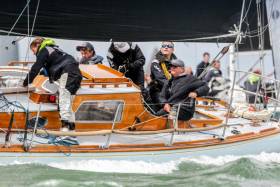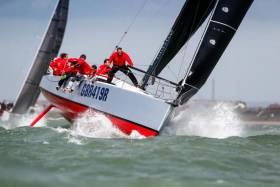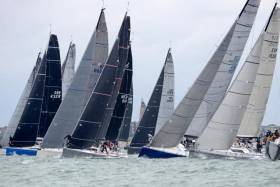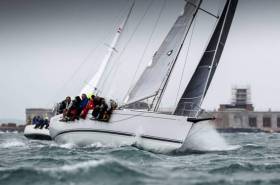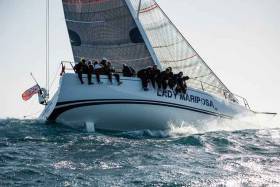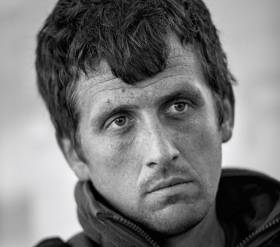Displaying items by tag: RORC
Second UK IRC Nationals Title for Whooper
With a near perfect scoreline, Giovanni Belgrano's 1939 classic yacht Whooper was crowned 2017 champion at the Royal Ocean Racing Club's IRC Nationals. Today, two windward-leeward races were held on the Solent in similar brisk southwesterlies to the first two days. This year's event may not have been an 'all-round test' weather-wise, but has been extremely challenging in terms of preparation and boat handling.
During the event Whooper, a classic Laurent Giles sloop that was previously IRC National Champion in 2004, scored six bullets, a fourth and a discardable DNF in the final race.
Whooper is no rating demon. She is optimised with modern sails and Belgrano has an experienced crew who do 60-70 races/year.
Elsewhere, the racing was extremely close. In the FAST 40+, Johnny Vincent's Pace fended off charges from Peter Morton's brand new Carkeek 40 Mk3, Girls on Film to win by a slender two points. Today Pace scored a 1-3 to Girls on Film's 2-1.
IRC One concluded with a dog fight for the lead between the Ker 46 Lady Mariposa and Ker 40 Keronimo. The larger boat held a two point lead going into the final race in which they suffered a major blow, being over the start line early.
Finally they managed to shake Keronimo off and were able to get up to speed until they had to make a last minute change to their lighter spinnaker, despite the wind building to above 20 knots. "We were praying that it would hold to the finish," recalled Hardy. Ultimately finishing fourth to Keronimo's second left them tied on points, claiming IRC One on countback.
In IRC Two there was a leader change with Ed Fishwick's Sun Fast 3600 Redshift Reloaded, leader all weekend, finally trounced by Adam Gosling's JPK 1080+ Yes! who came very close to successfully defending their IRC Nationals title.
As to relinquishing the IRC National title to Whooper, Gosling said: "Giovanni sails really well. He's campaigned Whooper for a long time. It is nice to see an old boat win."
Results are here
Strong Wind Start To RORC IRC Nationals
With the southwesterly piping up to 30 knots in the final race, the RORC IRC Nationals got off to a brisk start on the Solent today with two windward-leewards followed by a round the cans race.
Appropriately, given this is an annual championship for Royal Ocean Racing Club's rating rule, it is a mix of both the newest boats and the very oldest, that lead at the conclusion of day one.
Star performer was Ed Fishwick's Redshift Reloaded which scored straight bullets in IRC Two and now lead reigning IRC National Champion, Adam Gosling on the JPK 1080+ Yes! by five points.
Fishwick typically races his new Sun Fast 3600 doublehanded offshore, but has a full crew for this event. "Today it was mainly about getting good starts and staying upright," he explained. "We are one of the lower rated boats in IRC Two, so it was critical to get good starts and we got them, which meant we were in touch all the way up the first beat. It was very shifty and we had to do an unusual amount of tacking on shifts, but we got it right."
While their competitors were broaching around them, Redshift Reloaded's broad beam and twin rudders helped the crew keep her on her feet as the wind reached 28 knots, although even they suffered one wipe out.
The attrition rate was highest in the FAST40+ class where only four of the nine entries completed the third race. At the end of the race two, Johnny Vincent's Ker 40+ Pace was tied on points with Girls on Film, the brand new Carkeek 40 Mk3 of 2016 FAST 40+ champion, Peter Morton. However, this was not to continue for Morton, who recounted: "The problem was that our bilge pumps weren't working and we were slowly filling up with water which we couldn't get rid of. In the third race we were going down. We had about 2.5 tonnes of water on board and couldn't finish the race."
Nonetheless Morton was pleased with their performance up until then on his brand new boat. "The first time we pulled a spinnaker up was at the weather mark, but the boat feels really good. We are fast upwind and downwind. It's just not designed to carry two tonnes of water..."
The previous Girls on Film, now Bastiaan Voogd's Hitchhiker holds second, tied on points with Mark Rijkse's 42°South, with Pace leading by six points.
In IRC One, Andy Williams's Keronimo is also leading on six points after scoring a consistent 2-2-1 today - a fine performance, this being the Plymouth-based Ker 40's first major outing of the year.
"We had an up and down day - it was quite busy and bumpy and windy, but we really enjoyed it," recounted Williams. However it nearly all unravelled in the breezy final race. "We managed to drop the A4 in the water on the hoist and shredded it with the whole race ahead. But we worked very hard and what got us the race was the last leg - it was a tight reach and we flew an A0 fractional. We were underwater doing 17-18 knots all the way down and we literally made all our time with everyone hanging out the side, properly submerged."
In the first two races Keronimo was playing second fiddle to her bigger, newer brother, the Ker 46 Lady Mariposa. She is fastest boat in IRC One, but had to retire from race three with broken battens.
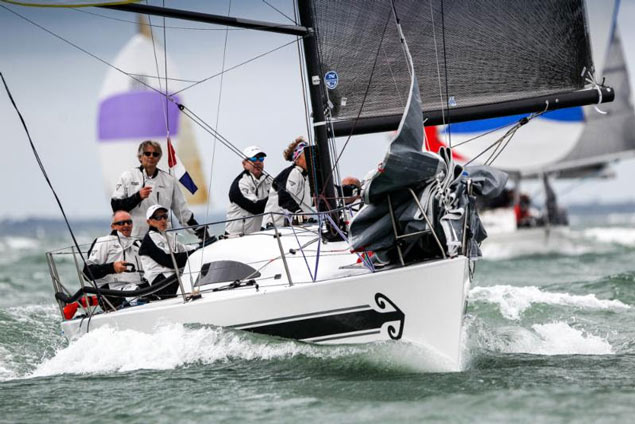 Racing in IRC Three, Philip Plumtree's Halftonner, Swuzzlebubble Photo: Paul Wyeth
Racing in IRC Three, Philip Plumtree's Halftonner, Swuzzlebubble Photo: Paul Wyeth
In IRC Three, Mike Bridges' Elan 37 Elaine won race one, but in the second and third it was the turn of renowned structural engineer Giovanni Belgrano and his Laurent Giles classic shoal-draught centreboard sloop, Whooper, winning both races to take the lead overall. A 1939 vintage, Whooper is the oldest boat competing and won the IRC Nationals back in 2004 when Belgrano says conditions were similar to today.
"It was a battle for everyone," said Belgrano of racing today. "But we do well against the modern boats in these conditions." Whooper was progressively reefed during the day, having started off on too generous a jib.
"She has a good hull shape, she was ahead of her time," added Belgrano of his steed. With a displacement of 7.2 tonnes, Whooper has great stability, but even she came a cropper in the lumpy wind-against-tide seas. "We were doing 11-12 knots. We did what may have been our first nosedive and we had green water on the foredeck. We came out of a gybe and we were probably 70° on our side," concluded Belgrano.
Tonight many teams are licking their wounds with much boat work to complete before another full day of racing tomorrow.
Royal Ocean Racing Club's IRC Nationals Has 53–Boat Fleet
Racing gets under way this Friday on the Solent for the cream of the British keelboat fleet at the Royal Ocean Racing Club's IRC Nationals writes James Boyd.
The rating rule will create a level playing field between the 53 boats entered ranging from the fastest, the Ker 46 Lady Mariposa, to the slowest, the two Quarter Tonners. In between it must cope with planing machines such as the eight FAST40s or Jamie Rankin's Farr 280, Pandemonium, to the Quarter and Half Tonners originally designed to the IOR rule to Giovanni Belgrano's 1939 Laurent Giles classic, Whooper.
Three 46 footers are competing. In addition to Lady Mariposa is Colin Campbell's Azuree 46 Eclectic, theoretically slowest of the trio. In between is the Marc Lombard-designed Pata Negra, chartered for the summer by the Dutch de Graaf family, who previously campaigned the Ker 40, Baraka GP.
In IRC One they will also face their old foe, Andy Williams' Ker 40 Keronimo, and Tor McLaren's MAT 1180, Gallivanter. There will also be a trio of J/111s, Simon Bamford's Kestrel, Paul Griffiths' Jagerbomb and Cornel Riklin's Jitterbug.
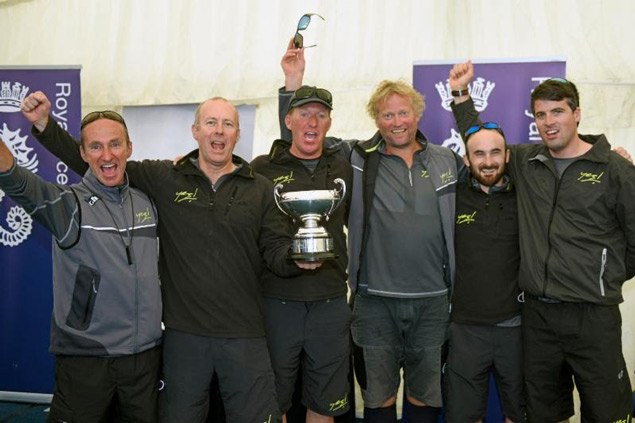 Adam Gosling's JPK 1080 Yes! is back to defend their title as joint winners last year with Irish crew James Hynes (third from left) and Nicholas O'Leary (right) Photo: Rick Tomlinson
Adam Gosling's JPK 1080 Yes! is back to defend their title as joint winners last year with Irish crew James Hynes (third from left) and Nicholas O'Leary (right) Photo: Rick Tomlinson
A favourite for this year's title is former RORC Commodore Mike Greville and his trusty Ker 39, Erivale, having come so close to winning last year.
Among the eight FAST 40+s all eyes will be on the latest generation Carkeek design, Girls on Film of 2016 class winner Peter Morton. With a modified cockpit layout compared to her predecessor (now Bastiaan Voogd's Hitchhiker), the IRC Nationals will be her first competitive outing having freshly arrived from her builder in Dubai.
IRC Two will see a dust up between five First 40s, including La Reponse of RORC Admiral Andrew McIrvine, who memorably scored three straight bullets on the final day of the IRC Nationals. On that occasion he was beaten to the class win by Adam Gosling's JPK 1080+ Yes!, ultimately crowned joint IRC National Champion. Yes! will return to defend her title.
IRC Three includes regular campaigners such as Harry Heijst's S&S 41 classic, Winsome, Mike Moxley's HOD35 Malice and Mike Bridges' Elan 37 Elaine.
Alongside Quarter Tonners, Berry Aarts' Wings and Tom Hill's Belinda, Phil Plumtree's Half Tonner, Swuzzlebubble, and Whooper, one of the lowest rated is the Poole-based MG 346, MS Amlin Enigma of Ian Braham.
Racing at the RORC IRC Nationals takes place over 23-25th June with a first warning signal each day at 1050
British First 44.7, Lisa, is the overall winner of the 2017 Morgan Cup Race. Owned by Nick & Suzy Jones and skippered by RORC Commodore, Michael Boyd of the Royal Irish Yacht Club on Dublin Bay. The Corinthian team scored a memorable victory after IRC time correction. 94 yachts completing the 125 mile course across the English Channel in blustery conditions. The crucial part of Lisa's victory came right at the end of the race.
“You need a good slice of luck to win a RORC offshore overall, as the conditions really need to suite your particular class” smiled RORC Commodore, Michael Boyd. “For Lisa, the tide changed near the end, which slowed the boats down behind us. We stayed inshore for a bit of rock hopping in the final few miles and it paid off. I would like to praise all the team racing Lisa, especially Suzi and Nick (Jones). We would like to dedicate the win to our absent navigator, who has a knee injury. Neil Morton, this win was for you.”
Five time Figaro competitor, Jacques Pelletier, racing Milon 41, L'Ange De Milon, finished the Morgan Cup just over a minute behind Lisa, to claim second overall. About 15 minutes later, Gilles Fournier and Corinne Migraine, J/133 Pintia, crossed the line. After IRC time correction Pintia was third by just two seconds.
Windward Sailing's CM60, Venomous skippered by Derek Saunders, took Line Honours and victory in IRC Zero, in an elapsed time of just over 17 hours. L'Ange De Milon was the winner of IRC 1, ahead of Maxime de Mareuil's French xp-44 Orange Mecanix2. Mike Greville's British Ker 39, Erivale III was third in class. In IRC Two Lisa was the winner with Pintia second. Stephen Hopson's JPK 10.80 Blue Note was third in IRC 2, racing Two Handed.
A tremendous battle in IRC 3 was played out by two French JPK 1080s. Marc Alperovitch's Timeline took Line Honours for the class and after IRC time correction, won by just 26 seconds, ahead of Delamare & Mordret's Dream Pearls. Rob Craigie's Sunfast 3600 Bellino was third in class racing Two Handed. In IRC 4, Marc Noel racing French Norlin 37 China Girl, corrected out to win the class, ahead of two British teams; David Cooper racing Dehler 38 Longue Pierre and David Gough's Elan 333 Aventurera.
In the Class40 Division, Halvard Mabire's Campagne de France continued their fine for this season, winning their class by over one hour.
In IRC Two Handed, the top seven places all went to British boats, the top three separated by just 2 minutes 17 seconds after IRC time correction. It was Rob Craigie and Deb Fish sailing Rob’s Sunfast 3600, Bellino that was the winner, just under ten minutes ahead of Ed Fishwick's Sunfast 3600 Redshift Reloaded. Charles Emmett's superbly sailed Sigma 36, British Beagle was third. Charles was leading the Two Handed Class, IRC 4 and the race overall for long periods of the race, however the tide and a softening breeze robbed them of victory on the South Coast of Guernsey. Fair respect should to the smaller yachts in the race completing Two Handed. Blackburn & Dipple's Sunfast 3200, All or Nothing, along with Jonty Layfield's J/11s, Sleeper and Alan Thornewill's JOD 35, Ginger.
The Royal Ocean Racing Club's Season's Points Championship consists of a testing series of races which attracts an international and varied fleet. For the serious offshore sailor, trying to win the Season's Points Championship is a real challenge. The Season's Points Championship this year includes the tactically and physically challenging Rolex Fastnet Race, one of the oldest and most prestigious offshore yacht races in the world.
JPK 10.80 Dream Pearls Takes RORC's De Guingand Bowl
In a weekend that saw the only Irish JPK10.80, Rockabill VI, win the biggest ISORA race for many years, Arnaud Delamare and Eric Mordret's sister ship Dream Pearls has won the Royal Ocean Racing Club's De Guingand Bowl Race. In second place was Noel Racine's JPK 10.10 Foggy Dew and third overall was the British Two Handed team of Ian Hoddle and Ollie Wyatt, racing Sunfast 3600 Game On.
Line Honours for the De Guingand Bowl Race went to Piet Vroon's Dutch Ker 51 Tonnerre de Breskens, 36 minutes ahead of their nearest rival, Daniel Hardy's Ker 46 Lady Mariposa. After IRC time correction Lady Mariposa was the winner the big boat class, IRC Zero.
“A very competitive race for us and we are delighted to win the first race of our campaign for the Rolex Fastnet Race” commented Dream Pearls' Christian Maby. “We were happy with our speed and we made some very good decisions with sail selection, especially using our Code Zero on the leg back to St. Catherine's Point. If there was one part of the race that we made significant gains it was there. When we finished, we could see boats around us in IRC Two, so we knew we had done well, but to win is fantastic for the team, and this will give us good hope for the season.”
IRC Three was the biggest class with 27 yachts competing; Dream Pearls took the class win, as well as the overall with Game On second and Thomas Kneen's JPK 10.80 Sunrise in third.
Ian Hoddle's Game On had a terrific race, winning the 20-strong IRC Two Handed Class and placing third overall. However Game On was pushed all the way. In IRC Two Handed Nigel De Quervain Colley's Fastrak XI was only two minutes behind and Ed Fishwick's Redshift Reloaded less than three minutes, after IRC time correction.
“Having been beaten by Bellino and Redshift in the Cervantes Trophy, we were keen to strike back immediately” commented Ian Hoddle. “We nailed a more aggressive start, which paid off as we were in the leading pack on the kite-leg down to the forts. The intensity of competition in the Two Handed fleet is such that a good start can make all the difference. North Head was the low point of our race; a broken jib shackle delayed our kite hoist and the time to fix it and a foul tide punished us. At this point the competition had all positioned themselves for the maximum tide running out of Portland. We continued across to Swanage to see if the anticipated lift provided gains; and it worked to a tee. We made the East Shingles Buoy without a tack and even got the Code Zero aloft! Both Ollie and I had certainly left nothing on the table and by 2am we were exhausted!! Ollie and I last raced together back in 2011. I have never seen someone with so much energy - he literally never stops working around the boat - like a machine :)”
Congratulations to Angus Bates' J/133 Assarain IV, winner of IRC One, Nick & Suzi Jones' First 44.7 Lisa, winner of IRC Two, and Antoine Magre's Palanad II, winner of the Class40 Division. The next race in the 2017 RORC Season's Points Championship will be the Myth of Malham. Mirroring the start of the Rolex Fastnet course, the 256 nautical mile race around the Eddytstone Lighthouse, will be the first weighted race of the championship, with a points factor of 1.2.
Racing Manager Job At Royal Ocean Racing Club
The Royal Ocean Racing Club is inviting applications from suitable candidates for the post of Racing Manager to direct a small but energetic race management team based in Cowes.
The RORC is an international members' club with clubhouses in London and Cowes. It has a very busy race programme organising up to 20 races per season in the UK and abroad. RORC's signature event is the biennial Rolex Fastnet Race which has over 300 boats taking part and the RORC Season Points Championship is a much-coveted series of offshore races running at regular intervals from February to November. RORC also runs a series of inshore events including the RORC Easter Challenge, Vice Admirals Cup, IRC National Championships and Commodores' Cup. Recent expansions of the annual programme include European and World championships
The successful candidate will have first-hand experience of yacht and keelboat racing both inshore and offshore and a network of contacts within the professional yacht racing community. A proven record of managing people, projects and budgets is essential plus good communication and interpersonal skills. An understanding of commercial sponsorship and experience in marketing and communications would be valuable to the role.
The role will involve travelling to events within Europe, America and the Caribbean and weekend work for which time off in lieu will be given.
Salary is negotiable according to experience but a range of benefits include a pension scheme, life and travel insurance and 25 days' annual leave. An annual performance bonus may be awarded.
A full job description can be sent upon application. Closing date for applications is Thursday 1st June 2017.
Send covering letter and CV's by post to:
Royal Ocean Racing Club
20 St James' Place
London SW1A 1NN
RORC De Guingand Bowl Race Preview
The Royal Ocean Racing Club's offshore racing season continues this weekend with the 4th race of the RORC Season's Points Championship. Over 80 yachts are expected to take part with the vast majority of the crews made up of passionate Corinthian sailors with their own set of goals.
Designed to last 24-36 hours, the De Guingand Bowl Race starts and finishes in the Solent and is a flexi-course allowing the Royal Ocean Racing Club to design a bespoke course.
"Without the constraint of finishing the race in a totally different location, we concentrate on the weather and tidal conditions to decide the course," explains RORC Racing Manager, Nick Elliott. "We try to get all of the fleet to finish the first beat in the same tidal vector, so as to avoid a tidal gate early in the race.”
In IRC Zero, Daniel Hardy's Ker 46 Lady Mariposa is the fastest yacht rated under the IRC rating system. However, several yachts in IRC One could challenge Lady Mariposa for Line Honours including Alan Hannon's RP45 Katsu, Edward Broadway's Ker 40 Hooligan VII, and Tor McLaren's MAT 1180 Gallivanter.
In IRC Two, Richard Neocleous' Ocean 55 Julia returns after its debut in last season's championship. The crew come from Hertfordshire and 18 year old Louie Neocleous will skipper Julia as he did last year.
“2016 was a great opportunity to put the team together and we all learnt a huge amount throughout the season.” commented Louie. “This year we are back to race much more competitively, we have a permanent race crew of 8. The remaining 6 crew are all friends, the boat's mate, Simon Jackson and I have crossed the Atlantic together and built a great relationship for the races. Last year, we were just beginners in terms of racing, our best result was 25th out of 86 boats in the Cervantes Trophy. This year, we hope to achieve better results on a consistent basis.”
In IRC Three, Trevor Sainty and Simon Forbes Jelenko is one of many J/109s that will be racing with the RORC this season. The crew have been together for about ten years and did their first Rolex Fastnet with Jelenko in 2015. The De Guingand Bowl Race is part of the teams programme for another crack at the Rolex Fastnet.
“All amateurs and we are all friends, most of the time.” smiled Trevor. “I am a veterinary surgeon working with horses, Simon works in the City, and the rest of the group are from the South of England and London, working in banking and IT. Our aim is to be top J/109 this season and improve our Fastnet finishing position by winning it of course. This will be my eighth consecutive Fastnet and last! - I said that last time.”
In IRC Four Dave Cooper & Paul England will be racing their Dehler 38 Longue Pierre. This will be their first RORC race this season, as part of their 2017 RORC Season’s Points Championship campaign.
“2017 is the 10th anniversary of us having won the great bowl overall.” commented Dave Cooper. This race will continue our rivalry with the Swan Xara. In 2016, we finished on equal points in JOG and the rivalry continues in both JOG and RORC this year. Longue Pierre is approaching her 30th birthday and has spent all of the last 30 years RORC racing.”
The 2017 De Guingand Bowl Race will start from the Royal Yacht Squadron Line, Cowes on Saturday 13th May
The world of sailing has so many sectors of interest that it’s challenging keeping track of the general picture. But even when you’ve achieved that basic level of comprehension, you then discover that each sector has so many sub-sectors that it all slips back into confusion. Once upon a time, W M Nixon though he’d a handle on the world of offshore racing. Now, he’s not so sure.
It’s all Tom Dolan’s fault. Most of you will know Tom as the farmboy from Meath who is cutting a remarkable swathe through the world of French Minitransat racing. Last week his name was back up in lights yet again after taking third in a fleet of 52 Minitransat boats in the 300-mile Pornichet Selector, which had these mighty atoms pinging up and down along France’s Biscay coast, with our man being overall leader at two stages.
He’s our Meath man now rather than a Meath farmboy, as he turned 30 on April 27th just after the race had finished. But he still has total boyish enthusiasm for the whole business, allied to a dogged yet adult dedication which is at such a level that it puts him on a different planet from most of the rest of us.
The plan for today was a quick look at Tom and what he’s doing as part of a general overview of the gradual regeneration of offshore racing and its various new areas of rapid development. But the problem is that, once you’ve sensed Tom’s enthusiasm and grasped just how utterly off the wall is his way of life, it takes over the whole show. So we’ll allow it to do so after a quick overview of the general scene.
And where better than to start with a quote from another man from Meath? We’ll always cherish the headline from The Meath Chronicle, when news of a certain sailing event in 1996 percolated through to the editorial headquarters of that esteemed journal in Navan:
LOBINSTOWN MAN WINS ROUND IRELAND YACHT RACE. That’s what it said. Real fame at last. Those of us who have a vague idea of Lobinstown’s location up near Nobber would have guessed it to be in Louth or even Monaghan. But not so, it’s clear over the border, into the Royal County and Meath Chronicle territory, and the Lobinstown man was Michael Boyd, who’d just knocked off the overall win in the big one with his J/35 Big Ears.
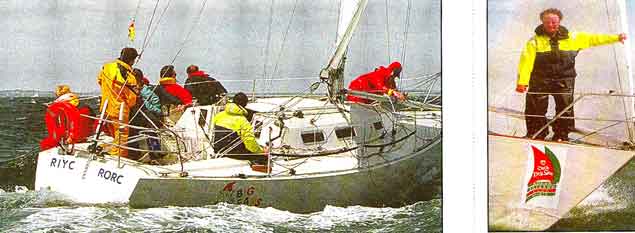 It’s 1996, and Michael Boyd’s J/35 Big Ears has just won Wicklow’s Round Ireland Race while her skipper (right) has become one of the earliest Afloat “Sailors of the Month”
It’s 1996, and Michael Boyd’s J/35 Big Ears has just won Wicklow’s Round Ireland Race while her skipper (right) has become one of the earliest Afloat “Sailors of the Month”
For that, he was our “Sailor of the Month” in the inaugural year of the contest, when we began to learn that monthly achievements, clearly highlighted at the time, amount to a very useful quick-reference history of Irish sailing years later. For the record, back in 1996 Big Ears was skippered by Michael Boyd with Jamie Boag (then 25) on navigation, tactics and alternate watch leader, Patsy Burke was relief helm and bowman, Brian Mehigan was bowman, ship’s doctor and cook, trimming team were P J Kennedy, David McHugh, Tim Greenwood and Michael Moloney, and Niall Dowling of the RIYC prepared the boat for the race.
Michael Boyd’s “Sailor of the Month” write-up also told us he’d done the Sydney-Hobart in 1993, the Newport-Bermuda in 1994, and the Fastnet in 1995, so with the Round Ireland won in 1996, you’d think that might be mission accomplished. But things were only getting going, and twenty years later he was back again – after much offshore racing since including being a winning co-skipper in the Irish Commodore’s Cup Team of 2014 – to race as Commodore Royal Ocean Racing Club in the 2016 Volvo Round Ireland Race, skippering the First 44.7 Lisa in which he was to finish third overall, and best Irish boat.
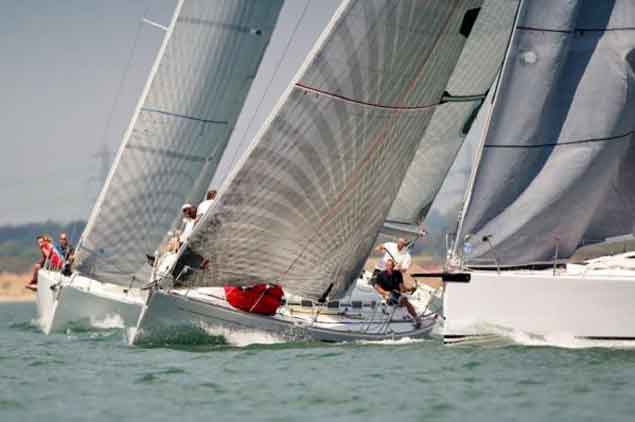 The First 44.7 Lisa at the start of the Volvo Round Ireland Race 2016
The First 44.7 Lisa at the start of the Volvo Round Ireland Race 2016
 Race organiser Theo Phelan around midnight in Wicklow with Michael Boyd when the latter had just finished the Volvo Round Ireland Race 2016 to place third overall.
Race organiser Theo Phelan around midnight in Wicklow with Michael Boyd when the latter had just finished the Volvo Round Ireland Race 2016 to place third overall.
Since then he has linked up with the JPK 10.80 Audrey for racing in Ireland, but he continues to make the scene with the core RORC programme in the English Channel with the First 44.7 Lisa, and last weekend he was one of a goodly fleet in the seasonal opener, the Cervantes Trophy from Cowes to Le Havre, with a very strong French contingent taking part.
0ne of them, the J/133 Pintia skippered by top French sailor Bruno Trouble, won overall from a fleet which reflected the fact that IRC continues to give very good racing for boats of all sizes, types and – in some cases – quite significant ages, as the J/133 dates from 2006, second by just 6 minutes was the Swan 44 Pomeroy Swan (Paul Kavanagh), third was Noel Racine’s regularly campaigned JPK 10.10 Foggy Dew, and fourth was the veteran Swan 55 yawl Lulotte (Ben Morris).
As for Lisa with Michael Boyd, she’d a good race, coming second to Pintia in Class 2, and ninth overall in a fleet of 84 starters. That looked like a pretty good turnout for the time of year, so Afloat.ie tracked down the Commodore of the RORC during the week to see did he share our feeling that there really is a new buzz to the offshore scene, and he responded with enthusiasm:
“Our sport seems to be in rude health these days, with much positive news to report. A Rolex Fastnet Race year always brings out many boats for the summer season. In last weekend’s Cervantes Race, RORC welcomed 84 starters, twice the 2016 figure, and 78 of them made it to Le Havre, more than four times last year’s number when a shocking squall had quite an impact.
Particularly gratifying are marked increases in women and young people taking part. And at home, the numbers are up for the Dun Laoghaire to Dingle race, and ISORA’s revival is a source of continuing joy. Long may it continue!”
-Michael Boyd, May 4th 2017
 Last weekend’s RORC Cervantes Trophy Race from Cowes to le Havre attracted 84 starters – double the 2016 entry – and Lisa placed second in Class 2 and 9th overall. Photo RORC/Rick Tomlinson
Last weekend’s RORC Cervantes Trophy Race from Cowes to le Havre attracted 84 starters – double the 2016 entry – and Lisa placed second in Class 2 and 9th overall. Photo RORC/Rick Tomlinson
In such a mood of goodwill, Afloat.ie didn’t delve too deeply into other interesting developments within the energetic RORC machine, where Dr Jason Smithwick – who has an impressive background in academia, the research industry, and international sailing administration - will be taking over the key role in administering the IRC. Nor indeed did we enquire further into last week’s rumour that our own Marcus Hutchinson is quietly working behind the scenes to bring about a rapprochement between the IRC and the ORC. Because the fact is, the season is upon us, and for the next three months, the business of racing is top of the agenda.
In the Irish Sea it has been at the top since April 22nd, when ISORA’s opening day saw season-starting coastal races on both sides of the Channel, with the Irish side doing best in turnout, 22 boats starting at Dun Laoghaire and finishing at Wicklow, with Andrew Algeo’s J/109 Juggerknot taking the honours.
It’s thanks to the dogged enthusiasm of people like Stephen Tudor in Pwllheli and Peter Ryan in Dun Laoghaire that ISORA has been kept going to be ready and waiting for the renewed interest in offshore racing. This new enthusiasm stems in part from a reaction against the pattern developing the major cruiser-racer regattas, where some race officers pride themselves on fitting in two or even three races in a day.
For those of the offshore racing frame of mind, one or two starts in a week is quite enough, thank you, and they like their races to take long enough to settle down and develop a character of their own. The feeling among such folk is that modern life ashore is often a case of trying to cram as many starts as possible into each day, and they only find genuine relaxation in an alternative challenge which is taken in a very different kind of time frame.
That – more or less – is the explanation given recently by someone who has succumbed to the charm of the modern ISORA programme, which has become so user-friendly that it even includes Howth’s Lambay Race on June 3rd. Admittedly it has a slightly lower points rating of 0.9, but with 35 miles to be sailed by the big boat classes, it is indeed a miniature offshore race, and one which at times give the taste of the sport at its best in terms of amateur enjoyment and a change from the hassles of shore life.
Thus although they’re both under the broad umbrella of offshore racing, there really could be no greater contrast than that between the sailing of your average ISORA enthusiast, and the sailing of Tom Dolan on the Minitransat circuit.
Growing up on a little farm beyond Kells in County Meath, one day Tom and his father got the notion of going sailing on the picturesque Lough Ramor just up the road, so they bought themselves a sailing boat of sorts in County Roscommon and – self-taught – they did indeed find that sailing had something for them.
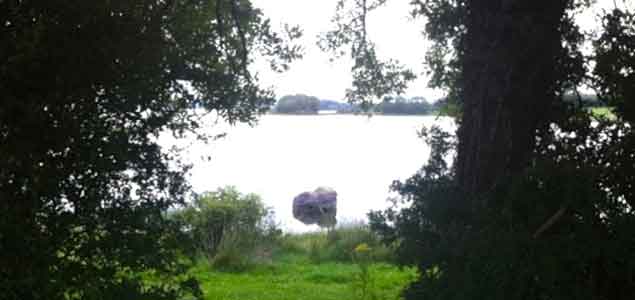 A long way from Concarneau.....Tom Dolan first discovered sailing on Lough Ramor.
A long way from Concarneau.....Tom Dolan first discovered sailing on Lough Ramor.
Even though the urge lay dormant in young Tom for his school years in Mullingar when Gaelic football and soccer took over his life, it was when he was 19 and at the outdoor activities education establishment Colaiste Dhulaigh, which is spread over four locations in Dublin and Malahide, that the sailing bug emerged again with an introduction to Glenans in Baltimore, and this time he was hooked for real.
Not only was he a natural sailor who was avid to learn more, but he proved to be a brilliant coach. There were others who realized that Tom Dolan was putting even more into sailing than he was taking out of it, and firm friendships were made, none firmer than that with Gerry Jones, who continues to live in Ireland where he has a busy working life. But he also acts as a voluntary agent for Tom, who in 2009 began to get involved in the sailing scene in France, and has steadily increased that involvement until he is now a leading figure in the Ministransat 650 programme.
It is by no means a gilded path he has chosen. Thirty million people in France may be closely interested in sailing, and they’ll take you to their Gallic hearts as you become part of their sailing scene. But the only sailing the Irish general public take much real interest in is the Olympics, and that’s when a medal may be in prospect. So an Irish rookie with very limited resources trying to get on the ladder in France – which is the only real ladder for high level offshore racing – has several mountains to climb.
But he knew what had to be done, and he knew how he could do it, for by this time he was being drawn into the 10-boat Minitransat community in Concarneau, which is well established as the CEMC (Centre d’Entrainement Mini de Concarneau). It sounds rather grand, but every cent has to be counted, and all involved are constantly looking for ways to increase income, maximise the boat’s performance, train and train again, and race.
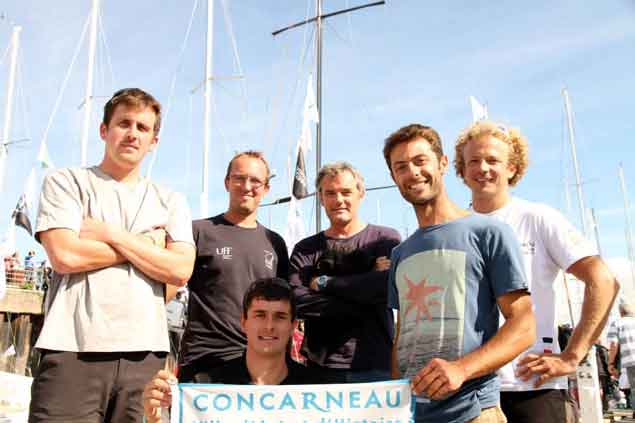 Members of the CEMC group at Concarneau, Tom Dolan on left
Members of the CEMC group at Concarneau, Tom Dolan on left
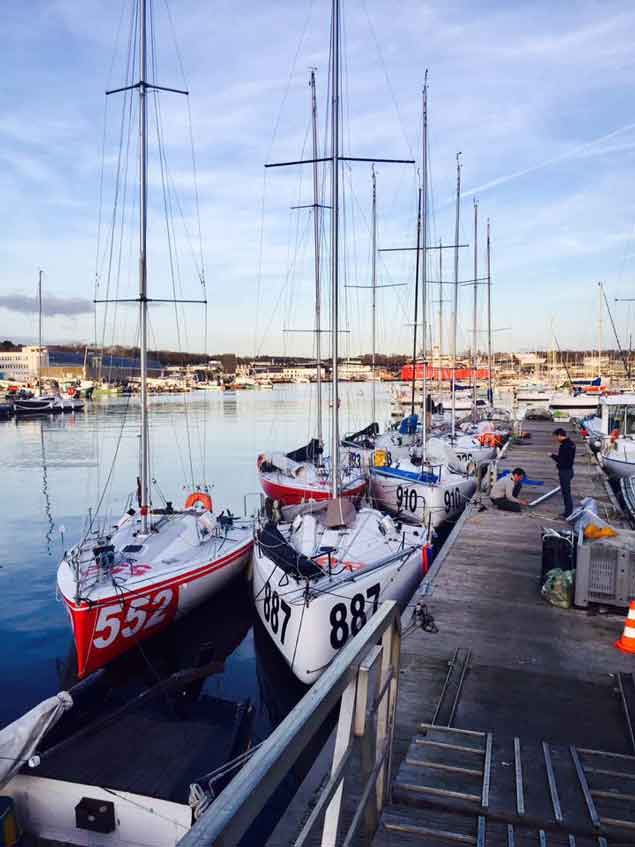 The Minitransat 650s of CEMC at Concarneau – Tom Dolan’s Pogo 650 Mark 3 (new in 2016) is number 910
The Minitransat 650s of CEMC at Concarneau – Tom Dolan’s Pogo 650 Mark 3 (new in 2016) is number 910
It’s worth it, as they have the great Gildas Mahe as coach, and last year every major race was won by one of the Concarneau group, including a victory for Tom himself. But getting to this level involved making a living doing deliveries and anything else involving high seas expertise, and using a borrowed Pogo 2 for his inaugural full season in 2015.
The Pogo 650 started life in 1995, and she’s now into Mark 3, one of the mainstays of the entire Minitransat scene. By 2015, the Mark 2 was off the pace, but Tom Dolan stuck at it to gain experience, and it was his father, with whom he’d shared those first sailing moments on Lough Ramor so many years ago, who made it possible to move on. For on his death in 2011, while the family farm was kept, he left Tom a modest legacy, and young Tom decided to blow the lot on getting involved with his own boat, and placed an order for the most basic available version of the Pogo 650 Mark 3.
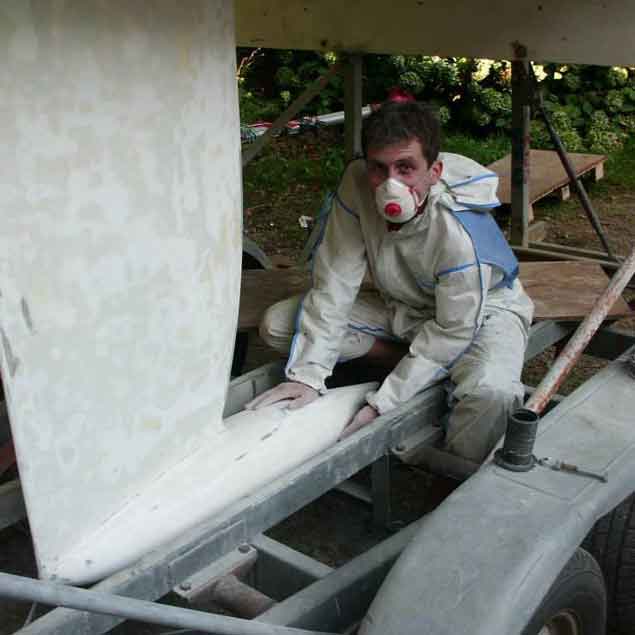 Tom getting the keel bulb perfectly faired. Members of CEMC expect to do most of their boat work themselves
Tom getting the keel bulb perfectly faired. Members of CEMC expect to do most of their boat work themselves
 Commissioning the new 2016 boat – IRL 910 – basically involved Tom in fully equipping a bare shell.
Commissioning the new 2016 boat – IRL 910 – basically involved Tom in fully equipping a bare shell.
He had much to do with installing electrics and equipment and just abut everything else from scratch before his new boat was ready to go racing in 2016, but it was well worth it, and by season’s end he was feted in the local press and internationally as “The Flying Irishman”. To keep the show on the road, he and his friend and fellow-skipper Francoise Jambou run their own 650 Training Centre which, with Tom’s brilliant coaching talents, provides a useful stream of income.
But as the sailing level escalates, so do the costs, and he’s very appreciative of sponsorship from home in the shape of Dubarry Ireland and Ding, while the strength of French interest in sailing generally is shown by support from Cellastab, Techniques Voiles, Renostye, Studio des Schizographes and of course his local pub, the Petite Bistro, where he’ll be celebrating the third place in the Pornichet Select 300 tonight, and maybe a toast to success in next Tuesday’s 500 miles race.
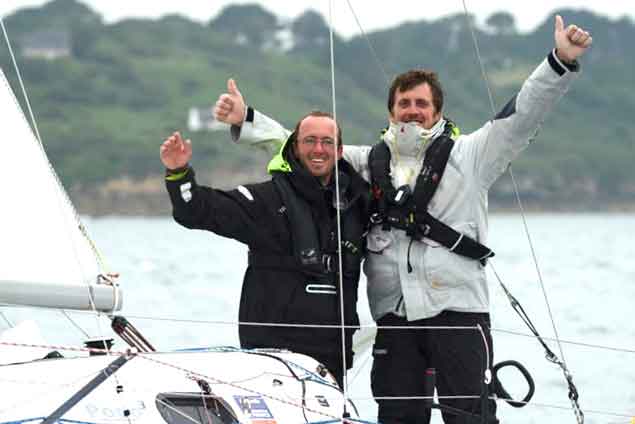 Tom Dolan (right) with sailing partner Francois Jambou celebrating victory with the new boat in a two-handed race.
Tom Dolan (right) with sailing partner Francois Jambou celebrating victory with the new boat in a two-handed race.
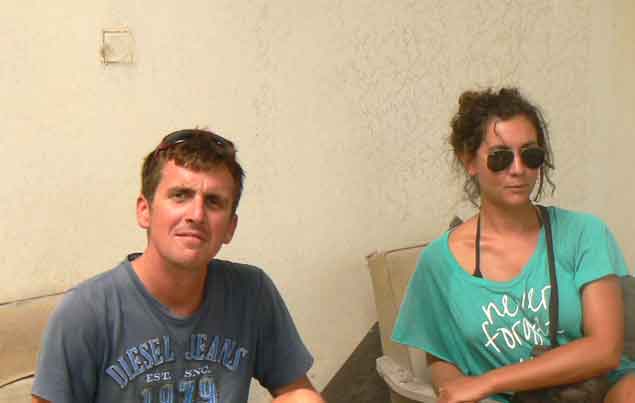 Tom from Meath and Karen from Lyons in Montserrat, where he’d sailed on a delivery voyage
Tom from Meath and Karen from Lyons in Montserrat, where he’d sailed on a delivery voyage
As for what it’s like being Concarneau-based on a year-round basis, even with the camaraderie and constant work and training of the CEMC, the winters can be long enough if you don’t line up a sunny delivery trip now and again. It was after one of these to the Caribbean and Montserrat that Tom met the significant other, Karen from Lyons, so now life back in Concarneau has a certain domesticity to it that was formerly lacking.
That said, domesticity is of a very rationed variety when you’re into sailing at this level, and Tom Dolan’s proposed programme for 2017 shows his level of commitment, and the continuing requirement for a solid sponsorship package, as the countdown to the Minitransat on October 1st at La Rochelle continues.
22nd April: Pornichet 350 Select (placed 3rd out of 52 boats)
May 9th Mini en Mai 500 miles
June 8th Trophee Marie-Agnes Peron
June 18th Mini Fastnet 600 miles (two-handed with Francois Jambou)
July 30th Transgascogne
October 1st Mini Transat (from La Rochelle)
Even as the programme is being implemented. Tom Dolan’s supporters behind the scenes are beavering away to put together a support package which will make the Mini-Transat a properly resourced challenge.
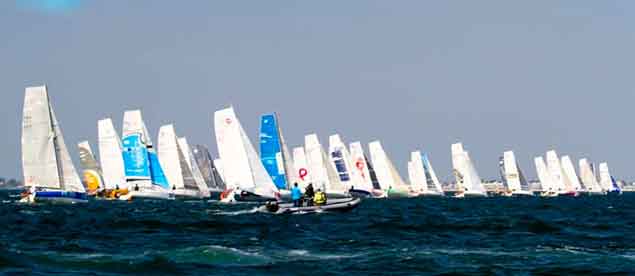 The contemporary French fleet of 52 actively-campaigned Mini 650s is an impressive sight on the starting line.
The contemporary French fleet of 52 actively-campaigned Mini 650s is an impressive sight on the starting line.
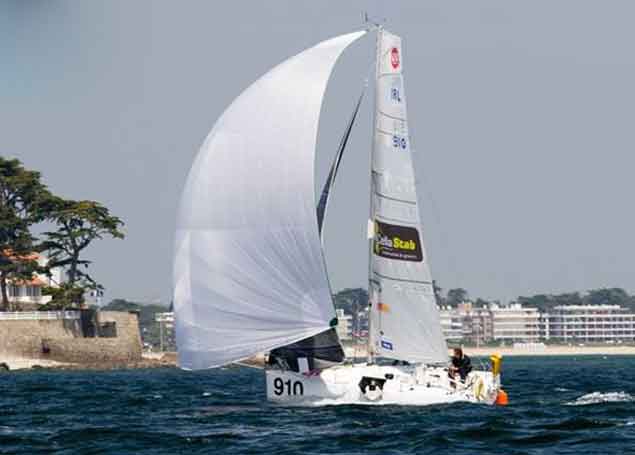 Getting clear and getting ahead – IRL 910 departs Pornichet
Getting clear and getting ahead – IRL 910 departs Pornichet
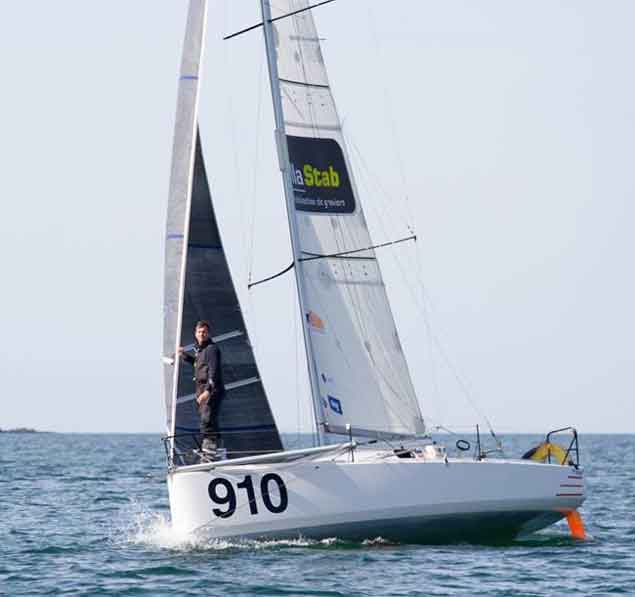 After being in the lead within five miles of the finish of the 300-mile Pornichet Select on April 26th, Tom Dolan in IRL 910 had to be content with third in the fleet of 52 at the finish.
After being in the lead within five miles of the finish of the 300-mile Pornichet Select on April 26th, Tom Dolan in IRL 910 had to be content with third in the fleet of 52 at the finish.
And beyond that? Team Tom Dolan are very interested in the confirmation of a decision which is expected to come from the Mid-Year Meeting of the World Sailing Council which is currently under way in Singapore (from May 5th to May 9th). Before it is the final acceptance of an invitation from the International Olympic Council to World Sailing to propose Showcase Events to be held alongside the Sailing Olympiad 2020 in Tokyo to demonstrate the potential of both kiteboarding and offshore racing to be Olympic events.
For offshore racing, the proposal is already taking shape for a 9-12m totally One-Design boat, to be raced two-handed, the fleet for the Showcase Event at Tokyo being envisaged at 18 to 20 boats. It’s emphasized that this is only a showcase, it’s not real Olympics. But it could be a guide for the future, and we’ve no doubt that if such an event were to be held in 2020 beside the Olympics, the participants would regard it as very much for real.
It’s certainly of considerable interest to Tom Dolan and his team, for they’re very aware that you’re in a different league in Ireland when you’re trying to raise support for an Olympic campaign rather than something which is seen as more of a niche interest.
But quite what your traditional offshore racer, setting off in their favourite ISORA or RORC event, will think of the prospect of their beloved sport being sucked down into the Olympic maelstrom is something else altogether - a topic for another day
The Lymington (UK) based Rating Office, headquarters of the world's most popular rating system IRC, is to be managed by Dr Jason Smithwick. Following on from academia, roles in the research industry and sailing's international federation Smithwick will take up his post at the head of a team of four full-time staff and several external consultants on 3rd July this year.
Established in 1974 the Rating Office has been coordinating the measurement of sailing boats and the issuing of rating certificates for over 43 years. Regarded by many as 'the centre of excellence for yacht measurement' it is one of very few mythical buildings in the world of sailing. The work that has been done inside its four walls over the years, producing ratings and handicaps for sailing boats of all shapes and sizes so as to race equitably over long and short courses, is the foundation piece of a huge multi-billion pound international sport and its associated industry. Over the years the Rating Office staff have been coordinating the measurement and rating of everything from IOR boats in the '70s and 80's, IMS in the early '90s and CHS in the '80s and '90s which evolved into IRC in use today.
In addition to calculating ratings the office is involved in the management, measurement and in some cases, the creation of class rules for fleets such as the Whitbread 60, the current VOR 65, the new Club Swan 50, Swan 45 class, Mumm 30 and Mumm 36 classes, Nautor Swans, Wallys, Maxi 72 and countless other sub-groupings that use the IRC Rule today. The Rating Office is also actively involved in international safety standards for yacht racing and has key roles in RYA and World Sailing working groups and committees.
Dr Jason Smithwick (45) graduated from Southampton University in 1994 continuing in the world of academia for another 10 years gaining his doctorate and eventually ending up as Principal Engineer & Software Manager at the world renowned Wolfson Unit. The next stage in his career was in the role of Technical and Offshore Director at sailing's international federation, known today as World Sailing.
"The role of Director of Rating is something that completely fits my experience and passion. Racing yachts, numbers and the greater racing community is what gets me out of bed in the morning. This is a dream job and I am honoured to follow in a long line of individuals that have handled this foundation piece of the sport of yacht racing and continue the important work that has been done by my predecessors and their colleagues," said Dr. Smithwick.
With rating rule stability in a dynamic technological age owners, clubs, sponsors and the marine industry at large can continue to invest with real confidence in the sport of sailing.
"I'm really pleased to find someone of Jason's experience and technical knowledge to head up the Rating Office in Lymington. The importance of the role played by the Rating Office staff over the years cannot be overstated. By calculating ratings and issuing rating certificates the foundation for equitable racing between disparate boats is established. This in turn enables many thousands of sailing boats to populate regatta and club race courses the world over. Jason's appointment will give IRC especially, and the sport in general, stability and real confidence for the future," said Eddie Warden Owen, RORC Chief Executive and Interim Rating Office Director
Giant International Yachting Gathering for Fastnet Race
August's Rolex Fastnet Race remains on track for a record-sized fleet. Currently 390 boats are entered: 338 competing for the main IRC handicap prize; the remainder racing for their own trophies in the Class40, IMOCA 60, Volvo Ocean 65 and Multihull grand prix classes.
This line-up makes the race the world's largest offshore race in terms of competitor numbers. Its entries are the most diverse, ranging from maxi-multihulls to the world's fastest monohulls, including those that compete in the fully crewed and singlehanded round the world races, to the racer cruisers and cruiser racers that form the majority of the IRC classes.
The fleet is also the most international. At the present tally, boats from 25 nations will be heading west down the Solent from Cowes on start day, Sunday 6th August.
As expected, the largest entry is from the UK with 58% of the fleet, but this means that 42%, or a whopping 164 boats, will have come from overseas.
France has dominated Rolex Fastnet Race results in both the IRC and non-IRC fleets in recent years and once again is back with a vengeance with the second largest entry, representing 13% of the fleet, followed by the Netherlands, Germany and Ireland with 7, 5 and 4% respectively.
Several teams will be making the journey from the furthest corners of the globe especially for the Rolex Fastnet Race. One of the most impressive efforts is from the Australian trio. This includes Finnish former Whitbread Round the World Race skipper Ludde Ingvall with his heavily remodelled Rolex Sydney Hobart Race line honours-winning maxi, CQS (ex-Nicorette). In her latest incarnation, this boat has been lengthened to 100ft and is futuristic-looking with a low volume reverse sheer bow, deck wings to increase her shroud base and a Dynamic Stability Systems lateral foil arrangement.
Also from down under, Rupert Henry's Judel-Vrolijk 62, Chinese Whisper will be back on familiar waters: She was previously Sir Peter Ogden's all-black 62ft Mini Maxi, Jethou. She is joined one of the most famous 'classic' maxis, Kialoa II, the elegant 73ft aluminium S&S design, enthusiastically raced by American Jim Kilroy from 1963-1973, when she won both the Transpac and Sydney Hobart races. She is now campaigned by Patrick Broughton.
As usual there are strong entries from the USA led by George David's Rambler 88 and Privateer, Ron O'Hanley's Cookson 50 competing a decade on from when Ger O'Rourke's sistership, Chieftain, won overall.
This year's race has its largest ever Asian entry with boats coming from Korea, Japan and China.
In the Class40, Japan's Hiroshi Kitada returns to the UK with his Pogo40 S3, Kiho, having competed in the Transat bakerly and Quebec-St Malo races last year.
From China is Ark323, skippered by Li Yun. This Botin & Carkeek-designed TP52 (ex-Sled/Warpath), in 2015 became mainland China's first entry with an all-Chinese crew in the Rolex Sydney Hobart. The boat is now making the long haul to the UK to compete in another of the internationally renowned 'classic 600 milers'.
Korea's first entry in the Rolex Fastnet Race comes in the form of the GP42 Sonic. Campaigned by Andrew Rho, Sonic has been one of the most competitive teams in Korea's burgeoning big boat racing scene.
Russia is becoming an increasingly major player in international yacht racing and will be fielding at least three entries including Pjotr Lezhnin Racing in the Class40, while in the IRC fleet is Sergei Zhedik's Sunfast 3600 Voyager and Igor Rytov's JPK 10.80 Bogatyr. Rytov competed in the last Rolex Fastnet Race as a crewman and, according to the Bogatyr team's Ivan Sharapov "he thought there was room for improvement, so he is doing it again on his own terms with a crew he's selected." Rytov acquired a JPK 10.80 following the victory of Géry Trentesaux's sistership Courrier Du Leon, in the last Rolex Fastnet Race.
Following on from its MOD70 entry in previous years, Oman Sail returns to the Rolex Fastnet Race this time in the Class40 fleet. Once again the crew will be led by French round the world sailor Sidney Gavignet who is spending this season coaching up top Omani sailor Fahad al Hasni in shorthanded offshore racing.
From the eastern Mediterranean, the race has a Turkish entry in Yigit Eroglu's First 35 F35 Express, while following the successful debut with Team Israel in last year's Brewin Dolphin Commodores' Cup, Omer Brand is returning with another Israeli crew, this time aboard Richard Loftus' Swan 65 and long serving competitor, Desperado. Brand and his crew will have to get used to some ancient Desperado traditions such as the black tie dinner at the Fastnet Rock not to mention the team's pet gorilla, Joe Powder.
"It is brilliant to see such a diverse fleet with huge international representation," says RORC CEO, Eddie Warden Owen."The Rolex Fastnet race is recognised worldwide as one of the most challenging 600 mile offshore races. It combines the tidal challenges of the Channel, with headlands to negotiate on the English South Coast, with open ocean racing in the Celtic Sea going to and from that iconic landmark, the Fastnet lighthouse off southern Ireland. Add to these navigational challenges typically unpredictable English weather which tests the seamanship and stamina of all the crew. This is why serious offshore sailors from all over the world want to take part."



























